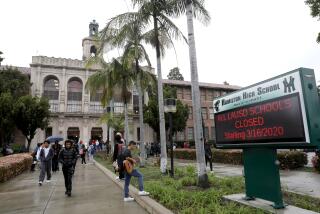Are charters a drain on traditional public schools?
Today’s topic: How much of a fiscal drain on state and local districts are charter schools? Is it necessarily bad that the proliferation of charter schools puts pressure on low-performing districts?
Charters are a legitimate part of the public school system
Point: Lisa Snell
Ralph, charter schools are the way to go. In a March speech on education policy, President Obama championed charter schools, praising their innovation and urging states to lift caps on their growth. Obama and U.S. Secretary of Education Arne Duncan have called for doubling the number of charter schools across the country. They want high-quality charter schools with proven track records to replace lower-performing schools.
Many urban school leaders in such places as Philadelphia, Newark and Oakland are embracing charters and developing specific plans to close low-performing schools and replicate high-quality charters. For example, the current issue of the Economist reports that, in Newark, 17 schools run by 12 charter-management groups teach almost 10% of the 48,000 children the city’s school system and that these numbers will soon double. Similarly, Philadelphia schools chief Arlene Ackerman has called for replacing 45 low-performing schools with higher-quality charter schools. School leaders have called for an expansion of charter schools because the evidence demonstrates that these schools are improving outcomes for the most disadvantaged and lowest-performing students.
Charter schools should not be viewed as a fiscal drain on school districts. Instead, they should be viewed as high-quality public schools that offer parents more options and raise school districts’ overall quality. Districts should embrace higher-performing charter schools and work to replicate and imitate these schools, which are adding value to their students’ education.
Look at Los Angeles and Oakland, where charter schools have had a positive effect on public education. In Los Angeles, more than 70% of charter schools outperform their nearby district schools. Ten of Los Angeles’ 12 recently recognized California Distinguished Schools are charter schools. Statewide, 12 of the 15 highest-performing public schools serving low-income students are charter schools. Similarly, in Oakland, the highest-performing schools are charters that have raised achievement for disadvantaged students.
In addition, these charter schools are improving performance for middle- and high school students where traditional public schools have often made the least progress. A recent study by the California Charter Schools Assn. found that the gains made in Oakland charters were most pronounced among middle- and high school students, and that these gains are increasing over time. Similarly, the March 2009 Rand Corp. study on charter schools in eight states found that charter students are more likely than traditional public school students to graduate high school and enroll in college.
The evidence that charters outperform district schools is coming in from across the nation. In New Orleans, where more than 55% of students are enrolled in charters, these schools continue to post faster achievement gains in reading and math for disadvantaged students. In Boston, a 2009 study conducted by researchers from Harvard University and the Massachusetts Institute of Technology found that Massachusetts charter schools are outperforming traditional public schools in both math and English.
In California, there is a strong demand from parents for more charter schools. In 2008, charter school enrollment in Los Angeles increased by 8,000 students, and many campuses have long waiting lists. The California Charter Schools Assn. reports that the number of charter schools would need to triple to accommodate all of the students currently on waiting lists in California.
Parents are desperate for more high-quality education options. Charter schools are not a fiscal drain on districts. They are public schools with impressive track records that should be viewed as a legitimate part of a high-performing public school system.
Lisa Snell is the director of education and child welfare at the Reason Foundation.
Why we don’t want charter ‘reforms’ in our public schools
Counterpoint: Ralph E. Shaffer
Lisa, charter school proponents argue that the competition provided by their unproven system forces traditional public schools to improve. Competition can be beneficial, but proliferation is not competition.
And charters are proliferating. The 700-plus California charters divert upward of $2 billion a year of scarce state funds from traditional public schools. The Los Angeles Unified School District loses nearly $7,000 in state money for each student who transfers to a charter. With almost 50,000 LAUSD kids in charters, it costs the district close to $350 million annually. Statewide, charters are responsible for about $1.5 billion in per-pupil revenue lost to school districts. That doesn’t include additional hundreds of millions for construction.
A Pulitzer-hungry Times reporter should ask, “Where does all that money go?”
Despite the massive amount of money taken from traditional districts, the charter system is filled with low-performing schools. On average, charters score lower than conventional schools. Jed Wallace, president of the California Charter School Assn., admitted in March that on the latest tests, charter students had a median score more than 20 points lower than students at traditional schools. Charters are further behind now than in previous annual reports.
A disproportionate number of the lowest-performing schools on the California State University system’s college readiness test are charters. At the top, except for small, specialized academies, public schools or conversion charters lead the list.
If charters are such a stimulus to improvement, why isn’t that reflected in a rapid improvement of those low-performing charters?
On Wednesday, Lisa, you credited nearly every reform that has occurred in Oakland Unified to the competition offered by charters. You wrote, “Competition from charter schools has led Oakland to embrace district-wide reform.” That ignores the efforts of Oakland teachers, who have consistently demanded change.
Lisa, you tout the fact that Oakland is the state’s most improved district, and your implication is that somehow the “success” of schools like American Indian Public Charter have forced the district to improve. Were that the case, Oakland would be without the frills that American Indian has banned -- computers and other technology -- and without traditional music, drama, art and athletic programs. Perhaps that’s why American Indian had only 18 students in its 2009 graduating class and the school has no waiting list.
Here’s another “frill” that school banned: In a city with a very large black population, there was no attempt made at American Indian to have students watch the president’s inauguration. That would have been a rare opportunity for discussions relevant to Oakland and those students. Is that the no-frills example, Lisa, that you think Oakland Unified should emulate?
The charter “reform” conservatives really want to expand to public schools is one in which a principal in the mold of American Indian’s Ben Chavis can fire college-tainted liberals “at will.” That’s the change critics of tenure -- think tanks and right-wing talk-show hosts -- want for Oakland, the LAUSD and every other district.
Fire “at will.” Whatever happened to the promise that charters would “empower” teachers? When a principal can fire “at will,” empowerment and innovation are gone.
With a popular, pro-charter president ready to throw gobs of money to charters and teacher organizations -- the California Teachers Assn., the National Education Assn. and the American Federation of Teachers alike -- that make sweetheart deals with charter organizers, the struggle to prevent the total destruction of American education by the home-schooling, voucher and charter juggernaut is probably lost. Our kids are not the only ones who will suffer. America loses.
Charters are not the kind of schools I would want my grandchildren to attend. Instead, they are in conventional schools that offer a well-rounded education, without forcing a particular ideology on them or using long-outdated teaching methods. Most public school districts recognize that there is more to education than standardized tests, which only turn out standardized students who score well on a test. But what have they learned?
Ralph E. Shaffer is a professor emeritus of history at Cal Poly Pomona.
More to Read
A cure for the common opinion
Get thought-provoking perspectives with our weekly newsletter.
You may occasionally receive promotional content from the Los Angeles Times.










